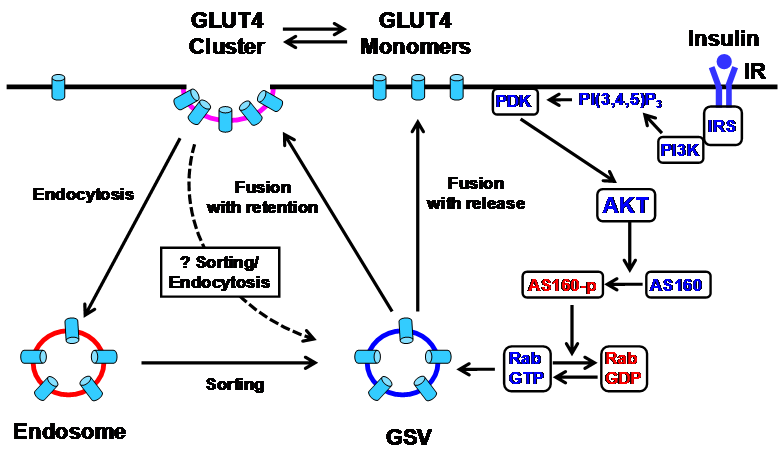
Insulin mechanism



Cross-Talk Between Iron Metabolism and Diabetes
Total insulin and IGF-I resistance in pancreatic beta cells causes overt diabetes. 2006
Insulin final targets
Glut4 exposure

Na+/H+ exchanger
In STZ rats supplemented with exogenous insulin NHE activity was positively correlated with serum insulin concentrations (r = 0.86, p < 0.01)
Acute and Chronic Regulation of the Renal Na+/H+ Exchanger NHE3 in Rats with STZ-Induced Diabetes mellitus 2006
NHE Vmax correlated with plasma insulin (r=0·80; P<0·001)
Intracellular pH, intrauterine growth and the insulin resistance syndrome 2001
Activation of NHE in insulin resistance might not be dependent to the lipid and glucose, but insulin levels.
Troglitazone could attenuate the platelet Na+/H+ exchanger activity in fructose fed borderline hypertensive rats 2001
Increased renal sodium retention is considered a major risk factor contributing to hypertension associated with chronic hyperinsulinemia and obesity. However, the molecular mechanism involved is not understood. The present study investigates the effect of insulin treatment on AT1 receptor expression and ANG II-induced stimulation of Na/H exchanger (NHE) and Na-K-ATPase (NKA) in opossum kidney (OK) cells, a proximal tubule cell line. The presence of the AT1 receptors in OK cells was confirmed by the specific binding of 125I-sar-ANG II and by detecting ~43-kDa protein on Western blot analysis with AT1 receptor antibody and blocking peptide as well as by expression of AT1 receptor mRNA as determined by RT-PCR. Insulin treatment (100 nM for 24 h) caused an increase in 125I-sar-ANG II binding, AT1 receptor protein content, and mRNA levels. The whole cell lysate and membrane showed similar insulin-induced increase in the AT1 receptor protein expression, which was blocked by genistein (100 nM), a tyrosine kinase inhibitor, and cycloheximide (1.5 µg/ml), a protein synthesis inhibitor. Determination of ethyl isopropyl amiloride-sensitive 22Na+ uptake, a measure of the NHE activity, revealed that ANG II (1–100 pM)-induced stimulation of NHE in insulin-treated cells was significantly greater than in the control cells. Similarly, ANG II (1–100 pM)-induced stimulation of ouabain-sensitive 86Rb+ uptake, a measure of NKA activity in insulin-treated cells, was significantly greater than in the control cells. ANG II stimulation of both the transporters was blocked by AT1 receptor antagonist losartan, suggesting the involvement of AT1 receptors. Thus chronic insulin treatment causes upregulation of AT1 receptors, which evoked ANG II-induced stimulation of NHE and NKA. We propose that insulin-induced increase in the renal AT1 receptor function serves as a mechanism responsible for the increased renal sodium reabsorption and thus may contribute to development of hypertension in conditions associated with hyperinsulinemia.
Insulin treatment enhances AT1 receptor function in OK cells 2005
Insulin activation of red blood cell (RBC) Na+/H+ (NHE) and Na+/Li+ (NLiE) exchanges is mimicked by okadaic acid, thus suggesting that it may change the state of phosphorylation of serine/threonine NHE residues.
Protein kinase C and insulin regulation of red blood cell Na+/H+ exchange. 1997
Objective Increased Na+-H+ exchanger activity (NHE) has been reported as an intermediate phenotype in hypertensive subjects, particularly those with insulin resistance.
Salt-loading elevates blood pressure and aggravates insulin resistance in Wistar fatty rats: a possible role for enhanced Na+-H+exchanger activity 2001
Insulin and cancer
Insulin, insulin receptors, and cancer, 2016 Fulltext